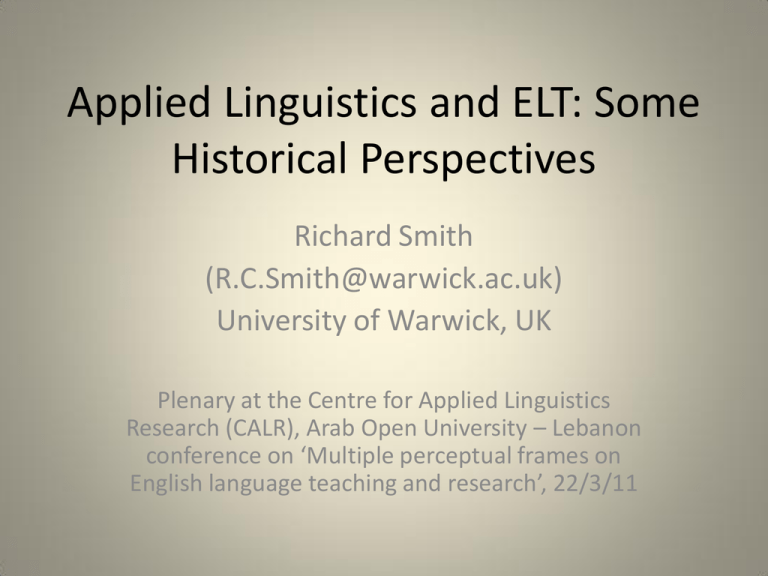Applied Linguistics and ELT: Some Historical Perspectives Richard Smith ()
advertisement

Applied Linguistics and ELT: Some Historical Perspectives Richard Smith (R.C.Smith@warwick.ac.uk) University of Warwick, UK Plenary at the Centre for Applied Linguistics Research (CALR), Arab Open University – Lebanon conference on ‘Multiple perceptual frames on English language teaching and research’, 22/3/11 Introduction • My interpretation of the conference theme of ‘multiple perceptual frames’: allegiance to constructivism (vs. positivism) Positivism vs Constructivism Positivism Ontology – There is a the nature of single, reality observable reality Epistemology We can know – the nature the world as it of knowledge really is Constructivism There are multiple realities Knowledge is socially and individually constituted • The central practical issue I shall keep in mind – improvement of English language teaching • Central question: how can / ‘should’ we construe the relationship between applied linguistics and ELT? • Adopting a historical approach to answer this question, I highlight different available ‘perceptual frames’, making reference to sources from the Warwick ELT Archive (www.warwick.ac.uk/go/elt_archive) Plan - Some past conceptions - A current crisis in the relationship between applied linguistics and ELT? - Some further historical perspectives (indicating future possibilities) 1. Some past conceptions 1. Applied linguistics in the USA Michigan (1948 +) A climate of positivism / universalism / confident applicationism The early work of Raja T. Nasr 2. Applied linguistics in the UK Edinburgh (1957 +) Corder (1973): Linguist -> Applied Linguist (course designer) -> Teacher Widdowson (1979, 1980) – ‘linguistics applied’ vs. ‘applied linguistics’ (as an autonomous, mediating, problem-oriented discipline) ‘I want to question the common assumption *…+ that a linguistic model of language must of necessity serve as the underlying frame of reference for language teaching’ (Widdowson 1979: 9) The ‘golden years’ of ELT-oriented applied linguistics in the UK (1970s-80s): Communicative Approach (syllabus design and principles of practice) 2. A current crisis in the relationship between applied linguistics and ELT? 1. A crisis of faith? Critiques of applied linguistics as ‘interested knowledge’ (e.g. Pennycook 1989, 1994, Phillipson 1992) -> The up-side to this: As yet unfulfilled possibilities of building on ‘local knowledge’ ‘*R+ather than trying to understand our practice according to some form of totalizing or universal discourse, we need to recognize the complexities of language teaching and its contexts, and strive to validate other, local forms of knowledge about language and teaching’ (Pennycook 1989: 613) 2. A crisis of neglect? Applied linguistics, defined as ‘the theoretical and empirical investigation of real-world problems in which language is a central issue’ (Brumfit 1997: 91) is no longer so centrally engaged with ELT. -> Unchecked commercial interests / danger of doors being reopened to linguistics applied? Some related arguments against Widdowson’s LA vs AL dichotomy: From a critical perspective both LA and AL (e.g. in the form of Communicative Approach) have been involved in similar ‘hegemonic’ (centre-periphery and top-down) relations with ELT practice They have tended to share a ‘technical’/ ‘universalist’ focus on linguistics / latterly, SLA as primary sources of insight However, at least in the past both LA and AL were (similarly) focused on and engaged with ELT practice – more so than applied linguistics may now tend to be. What does the British Council Directory of UK ELT Research (2005-2010) indicate? http://www.teachingenglish.org.uk/elt-research - Background / aims - Great diversity but no ‘unifying idea’ - International networks 3. Some further historical perspectives (indicating future possibilities) • Reasons for an applied linguistics concerned with ELT: ‘post-methodism’ (‘principles’ vs. rampant commercialism / patented methods) – Kumaravadivelu. Historical precedents: Prabhu, Stern, Mackey, Palmer, Sweet. • Possible need for a ‘rapprochement’ between LA and AL perspectives, with a united focus on ELT practice (cf. Palmer 1917, 1921, 1924)? • Continuing value of the (non-AL/LA) UK ‘ELT’ tradition: expertise derived from principled eclecticism / practical experimentation in context (e.g. Palmer, Hornby, etc.) Cf. Nasr (1972) • Needs for collaborative research with teachers, and prioritizing their needs (cf. Palmer in Japan, and his advocacy of ‘multiple lines of approach’ (1921, 1924)) Need to tap into desires for reform and perceptions of ‘good teaching’ among ‘nonnative speaker teachers’ in primary and secondary school education – cf. roots of the UK ELT tradition (via Palmer) in the late 19th century Reform Movement led by e.g. Vietor, Passy, and informed by academic, though pedagogically oriented phonetic descriptions (Sweet etc.) At the same time, we need to recognize limitations of both the ‘applied linguistics’ and the UK ‘ELT’ traditions: - Dominant linguistics/language emphasis - Limited, technical orientation (vs. social / political / educational considerations) - ‘Universalist’ / hegemonic tendencies ‘The key point, I think, is the need for teachers to keep their own counsel regarding what works and what does not work and to insist on an interpretation of events and ideas that includes, implicitly or explicitly, a validation of their own experiences in the classroom’ (Clarke 1994: 23) An end-point / starting-point [Within teacher education / ELT research / applied linguistics]: recognize the importance of context, and work in a ‘constructivist’ manner, collaboratively with teachers/learners, ‘from the bottom up’, on the basis of their priorities and their ‘multiple perceptual frames’, referring when this is appropriate to linguistic insights and insights from other disciplines. References See separate handout






